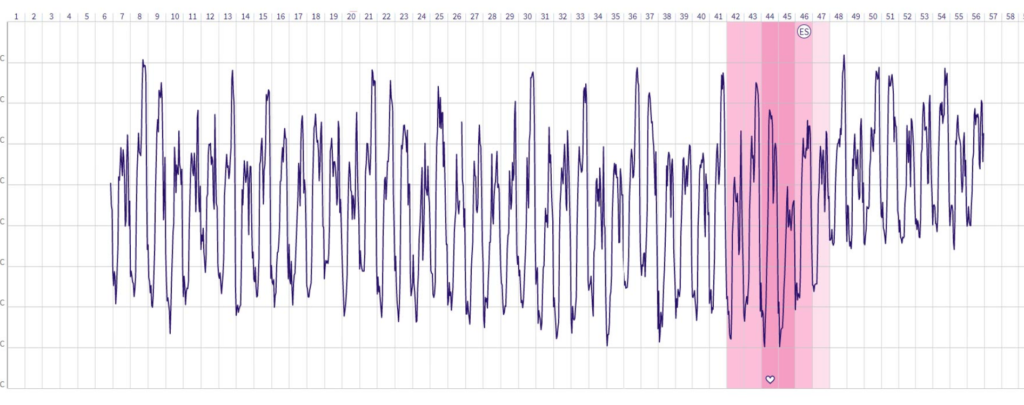Precise and simple cycle diagnostics with OvulaRing – also possible with PCOS
Polycystic ovary syndrome (PCOS) is one of the most common hormonal disorders in sexually mature women and makes it difficult or even impossible to have...
Von: Anne Alexander

Polycystic ovary syndrome (PCOS) is one of the most common hormonal disorders in sexually mature women and makes it difficult or even impossible to have a child. In Europe, 4-12% of women of childbearing age suffer from PCO syndrome; in Germany alone, about 1 million women are affected.
Various studies on the hormonal course of the female cycle prove that every woman has individual cycle patterns and that the respective hormonal processes have special features that characterize the cycle individually in physiological terms.
For example, studies² have demonstrated that over one third of women diagnosed with PCOS have had ovulation and can conceive naturally. Further, it has been confirmed that 15% of these women even regularly ovulate late after day 36. According to the latest scientific findings, the number of anovulatory cycles in PCOS women is not as high as previously thought! However, late ovulations often go undetected. Affected women are therefore often referred to the fertility center too quickly by the treating physician, although they could become pregnant spontaneously.
With OvulaRing, affected women can easily find out how their individual cycle works and whether and when they ovulate – no matter how late it may be. OvulaRing automatically measures core body temperature around the clock and stores 288 core body temperature values per day. Based on this, the fertile phase and ovulation are accurately indicated.
Especially in PCOS, it is crucial to continuously monitor the cycle in order to “detect” late, often undetected ovulation. This is especially important information for affected women before hormone treatments or interventions.
Background PCOS
PCOS has many facets and causes different symptoms, which are pronounced differently in each affected person so there is no uniform symptomatology. Thus, the detection of the eponymous polycystic ovaries alone is not necessary for the diagnosis of “PCOS”. On the other hand, the detection of polyfolliculosis does not always mean PCOS.
However, if at least two of the following three symptoms are present, it may indicate PCO syndrome:
1. Polycystic ovaries
Ultrasound shows many small follicles in the ovaries, which also enlarge the ovaries, where they are sometimes interpreted as cysts.
2. Oligo-/novulatory cycles
The length of the cycle can be significantly prolonged with more than 35 days up to the complete absence of the period. In a healthy cycle, a follicle grows and expels the mature and fertilized egg into the fallopian tube at the time of ovulation. A high level of male hormones, as is often present in PCO syndrome, impairs this maturation process. Only numerous immature precursors are formed, which do not develop further and cause the cystic transformation of the ovaries.
3. Excessive androgen production
Typical features of masculinization of body and sex characteristics include abnormal hair growth in unusual places (e.g., face, back, chest, or abdomen), overproduction of skin fat by the sebaceous glands, acne, and hair loss.
Research has shown that both genetic factors and environmental influences play a significant role. Characteristic in the development of PCO syndrome are hormone imbalances. The male sex hormones, so-called androgens, and the luteinizing and follicle-stimulating hormones (LH and FSH) of the pituitary gland are particularly affected. Obesity also seems to play a crucial role in the development of PCO syndrome. Often, obesity is accompanied by insulin resistance. The ovaries then respond to the increased insulin levels by converting less of the androgens into estrogens.
Other possible consequences of a PCO syndrome: Cyst formation on the ovaries, anovulation, irregular cycles, very long cycles, sterility, absence of menstruation, obesity, cardiovascular disease, unusually strong hair growth in unusual places, type 2 diabetes mellitus, hair loss, acne, increased testosterone levels, psychological and social problems, and a massive reduction in quality of life.
If you are affected by PCO and are unsure if and when you are ovulating, you can use OvulaRing. Even late ovulations will be accurately indicated.
Do you want to fulfill your dream to have a baby spontaneously? We would love to support you!
1 Direito A et al. (2012). Relationships between the luteinizing hormone surge and other characteristics of the menstrual cycle in normally ovulating women. Fertil Steril. doi: 10.1016/j.fertnstert.2012.08.047. Epub 2012 Sep 19.
² Der Privatarzt Gynäkologie, Medizin & Management. 2014. Sonderbericht: Zeitpunkt der Ovulation. Die fortlaufende Messung der Körperkerntemperatur gewährleistet zuverlässige Aufschlüsse; 3: S. 16-17




